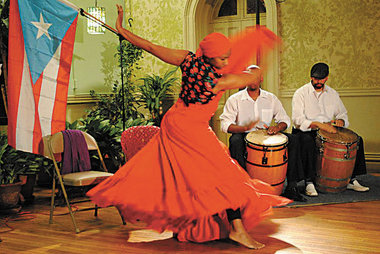


Lie woodblock on floor and use two sticks to hit them.Transfer these rhythms over to the instruments Have all students say the drum part while playing it on their knee and thigh Have students use one fist to say and “play” the maraca rhythm in the air Teach the rhythms for each instrument using speech and body percussion
Bomba dance movie#
Ask questions following the movie pertaining to bomba history and instruments. Viento de Agua performs a bomba with dancing and drums at the 2004 Smithsonian Folklife FestivalĪssessment: Listen and observe students to assess if they are singing the response section correctly.Teach simple bomba dance steps and dance to some of the examples played in class. Yes, I’ll go, yes, I’ll go, yes I’m heading for Mayaguez / Yes, I’ll go, yes, I’ll go, for they’re playing my balance (my rhythm)Įxtension: Watch another example of bomba on the Smithsonian website. Siré Siré, porque están tocando mi balancé Restart track and invite students to sing along to the response throughout the recording.Model singing the line to students and have students echo back.Speak each line and translate it for your students.Pause the music & teach students the response sung in Siré y Siré.Point out the response (multiple singers singing the same lines each time).Point out the call (one man singing, lyrics change).Listen to the track heard on the website ( Siré y Siré).
 Ask: “Does anyone have an idea on what call-and-response might mean?”. Expand on the first sentence in the third section, “Bomba is sung in call-and-response fashions”. Read the history and information of bomba. Navigate to “Rhythm” and then to “Bomba”. Bomba was also used for dancing and celebration, and helped inform community and identity. Bomba music was used as a form of political and spiritual expression. Bomba comes out of the musical traditions brought to the “New World” by enslaved Africans in the 17th century. Drumming and Dancing (National Standards 2, 3, 8). Smithsonian Folkways, “Siré y Siré” by Viento de Agua from Unplugged Materia Prima. The song of el coquí and other tales of Puerto Rico. Mohr, Nicholasa, and Antonio Martorell. Students will be able to improvise body movements with and without music. Students will be able to play in a percussion ensemble with multiple parts. Students will be able to play repeated rhythms on various unpitched percussion instruments with a steady tempo. Students will be able to create sounds to represent various body movements. This lesson focuses on the African influences found in Puerto Rico’s musical culture by studying bomba music.Ĭo-curricular Areas: Spanish, Social Studies, Language Arts, History Puerto Rican culture is a representation of the diverse heritages of three main cultural groups: Taíno Indians, Africans, and Spaniards.
Ask: “Does anyone have an idea on what call-and-response might mean?”. Expand on the first sentence in the third section, “Bomba is sung in call-and-response fashions”. Read the history and information of bomba. Navigate to “Rhythm” and then to “Bomba”. Bomba was also used for dancing and celebration, and helped inform community and identity. Bomba music was used as a form of political and spiritual expression. Bomba comes out of the musical traditions brought to the “New World” by enslaved Africans in the 17th century. Drumming and Dancing (National Standards 2, 3, 8). Smithsonian Folkways, “Siré y Siré” by Viento de Agua from Unplugged Materia Prima. The song of el coquí and other tales of Puerto Rico. Mohr, Nicholasa, and Antonio Martorell. Students will be able to improvise body movements with and without music. Students will be able to play in a percussion ensemble with multiple parts. Students will be able to play repeated rhythms on various unpitched percussion instruments with a steady tempo. Students will be able to create sounds to represent various body movements. This lesson focuses on the African influences found in Puerto Rico’s musical culture by studying bomba music.Ĭo-curricular Areas: Spanish, Social Studies, Language Arts, History Puerto Rican culture is a representation of the diverse heritages of three main cultural groups: Taíno Indians, Africans, and Spaniards.







 0 kommentar(er)
0 kommentar(er)
